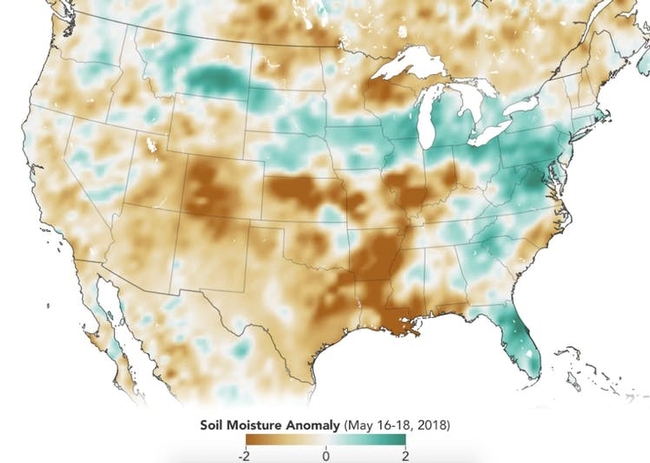NASA's Maps of Global Soil Conditions
Are the
Future of Farming
Find water anywhere.
By Mary von Aue
The US Department of Agriculture (USDA) is now using data collected from the first NASA satellite mission dedicated to measuring the water content of soils. These maps created by the space agency will be used to monitor global croplands, make commodity forecasts, and will help the USDA forecast crops globally.
The Soil Moisture Active Passive mission, or SMAP, launched in 2015 in order to map the amount of water in soils worldwide. On Friday, NASA announced that the agency is providing the mission with new tools developed by NASA's Goddard Space Flight Center that will better predict where there could be too much or too little moisture in the soil to sustain farming.
“There's a lot of need for understanding, monitoring and forecasting crops globally,” said John Bolten, a research scientist at Goddard. “SMAP is NASA's first satellite mission devoted to soil moisture, and this is a very straightforward approach to applying that data.” NASA presents the satellite data in maps that are rendered to resemble watercolor paintings. Soils that are wetter than normal are seen in shades of greens, while those that are drier than normal are seen in shades of browns.
Before this collaboration, the USDA had used computer models that would incorporate precipitation and temperature observations to indirectly calculate soil moisture. However, this approach was prone to error in areas that lacked high-quality, ground-based instrumentation to collect the data. Now, NASA is incorporating direct SMAP data on soil moisture into Crop Explorer, the USDA's Foreign Agricultural Service website that reports on regional droughts, floods, and crop forecasts.
The SMAP viewer is still in beta but is expected to provide updated global coverage every three days once it launches. The maps will be managed for NASA's Jet Propulsion Laboratory and will provide Crop Explorer with timely updates that are essential for monitoring conditions and forecasting productivity.
This cross-agency collaboration will do more than help the USDA identify farming trends. By monitoring moisture in the soil globally, scientists can more accurately forecast conditions that could have tremendous economic and social impact.
https://www.inverse.com/amp/article/45498-nasa-maps-of-global-soil-conditions-future-of-farming
Map created with NASA's SMAP data from May 16-18, 2018
Attached Images:
